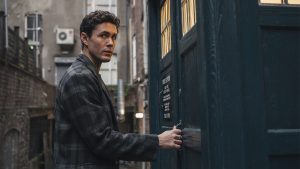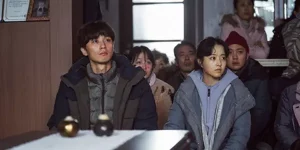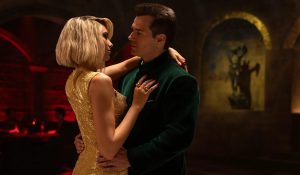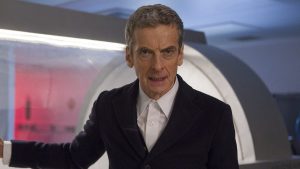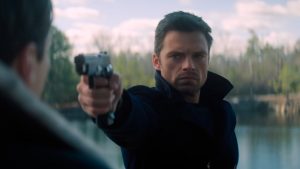
Fictional horror movies scare us until we leave the theater. True crime dramas follow us home because they happened once to someone—or so they say.
Heists, abuses of power, murders, and multiple murders. Hollywood loves crime and all the ill-gotten bootie it brings. From 1907’s The Unwritten Law: A Thrilling Drama Based on the Thaw-White Case to the upcoming Roofman, films inspired by true crime capture a special kind of imagination. They are cautionary tales with real-life consequences, and dramas too sordid for mixed company. In the Golden Age, stories of gangland thugs came with promises of being “ripped from today’s papers.” Every robbery is a drama. Each public scandal is a potential movie trailer. Every human tragedy is a closeup. Here are some of the best films that took their plots from schemes attempted in real life.
Zodiac (2007)
Directed by David Fincher, Zodiac is as exhilarating as it is frustrating. The Zodiac Killer case, which terrorized late 1960s San Francisco, has never been closed. The elusive serial killer taunted law enforcement, mailed cryptic ciphers to local newspapers, and left bloodstained clothing as belligerent markers. Yet his identity remains an unsolved mystery. The movie captures the feel of a terrified California, never knowing when the next victim would be chosen.
Though they top the credits, Jake Gyllenhaal, Mark Ruffalo, and Robert Downey Jr. are supporting actors to the suspense of Zodiac. The slow narrative burn is incremental, calculated, and never plodding. The story is based on Zodiac: The Shocking True Story of the Hunt for the Nation’s Most Elusive Serial Killer, by Robert Graysmith, who worked as a cartoonist at the San Francisco Chronicle during the spree. Fincher, screenwriter James Vanderbilt, and producer Bradley J. Fischer also conducted their own investigation into the murders. The results are admirably close to the exasperating reality of crime procedures. Some suspects get away with inconceivable crimes.
The French Connection (1971)
Director William Friedkin’s The French Connection is the closest a Hollywood blockbuster comes to an authentic on-the-street criminal investigation. All the cop movie clichés now taken for granted were invented in this motion picture classic. Gene Hackman’s Det. “Popeye” Doyle leads with his gut, picks his feet in Poughkeepsie, pisses off other cops, gets a kick out of needling the FBI, and is in the driver’s seat for the pinnacle car chase in cinema. His partner, Buddy “Cloudy” Russo (Roy Scheider), provides perfect backup, even taking a switchblade slice for the team.
The fictionalized adaptation of Robin Moore’s 1969 true crime book, The French Connection: A True Account of Cops, Narcotics, and International Conspiracy, documents the end of the Corsican mob’s alliance with Organized Crime founder Lucky Luciano for the production, refining, and distribution of heroin, allegedly through the Bonanno and Magaddino families. It was the first sniff to hook the movie-going public on Hollywood’s war on drugs. To experience the dangers of policework first-hand, Friedkin went on busts with the real-life Popeye Doyle during shooting. For his next film, The Exorcist (1973), the director would go to hell and back.
Goodfellas (1990)
Goodfellas, directed by Martin Scorsese, is the gangster genre’s greatest riches-to-rat story. Based on Nicholas Pileggi’s book Wiseguy, Ray Liotta stars as Henry Hill, who gave state’s evidence before escaping into the witness protection program to dodge a drug bust. Robert De Niro plays Lucchese family associate James “Jimmy the Gent” Burke, renamed Jimmy Conway for the movie, but displaying the authentic charm of the original. Joe Pesci plays Tommy DeVito (real name Tommy “Two Gun” DeSimone), for everything but laughs.
“As far back as I can remember, I always wanted to be a gangster,” Hill beams at the film’s opening. Scorsese makes crime palpably exhilarating. Clothes, cash, clubs, and coke can explode at a moment’s notice. Goodfellas doesn’t play out on the manicured lawns of The Godfather. These are street-level gangsters hijacking low-level loot until something bigger comes along. Famous before the movie was made, the Dec. 11, 1978, Lufthansa Heist at Kennedy International Airport is at the heart of Goodfellas. It is still one of the biggest thefts in American history, and remains unsolved. “The Gent” whacked anyone who could tie him to it. Goodfellas is a game-changing masterpiece of violence, humor, and underreported street crime.
The Wolf of Wall Street (2013)
Leonardo DiCaprio’s Jordan Belfort was raised by two middle-class accountants in a tiny Bayside, Queens apartment. He turned 26 the year he headed his own brokerage firm, pulling in $49 million, which was not the prime catch he’d calculated it to be since the predatory money-mover was chasing a million a week. Director Martin Scorsese’s The Wolf of Wall Street is based on the real Belfort’s memoir about his work as a Wall Street stockbroker. For DiCaprio, Belfort is a golden goose until the eggs drop in the “boiler room” to get scrambled into a penny-stock scam.
Scorsese knows how to make even the most egregious villainy fun, however fleetingly. The audience never forgets, however, that good times never make it to the closing credits. Ultimately convicted of fraud, market manipulation, and acts beyond fiduciary infractions, the young fiscal upstarts in this film exemplify the financial center’s wild and crazy frat boy behavior while the money lasts. Also starring Jonah Hill as Donnie Azoff, Margot Robbie as a fictionalized version of Belfort’s second wife, Naomi LaPaglia, and Matthew McConaughey as the most relaxed pocket-cash wizard on the planet, The Wolf of Wall Street is a roller coaster ride to fiduciary perdition.
Psycho (1960)
Alfred Hitchcock’s Psycho didn’t create the slasher movie, but it is the most influential cinematic example of the art. The horror film genre would never be the same after its intensely morbid fascination with details. The director used 78 camera setups and 52 cuts for the shower scene’s 45 seconds of screen time, and the images are etched in viewers’ minds forever. As is Marion Crane (Janet Leigh), the emotional center of the film until she’s unnervingly hacked from the frames, leaving the audience with no empathetic focus to relate to.
The Bates Motel check-out policy scenario is loosely based on evidence left by the 1950s’ “Butcher of Plainfield,” Ed Gein, who also inspired Leatherface in director Tobe Hooper’s The Texas Chainsaw Massacre (1974), and the Buffalo Bill killer from Jonathan Demme’s The Silence of the Lambs (1991). Hitchcock’s seminal work was inspired by author Robert Bloch’s 1959 novel Psycho, but only for speculation. The details of Gein’s crimes are condensed for universal fear, and only imagined as an ongoing event. Perkins projects an enigmatic air, lost between identities, content to sit and stare, unable to harm a fly. What mother could be prouder?
All the President’s Men (1976)
On Nov. 17, 1973, President Richard Nixon looked into the eyes of the American public watching a historically infamous televised Q&A session, and admitted, “People have got to know whether or not their president’s a crook.” As the Associated Press managing editors holding the event eagerly anticipated further confession, the president explained, “Well, I am not a crook. I’ve earned everything I’ve got.” In director Alan J. Pakula’s All the President’s Men, Robert Redford and Dustin Hoffman’s unlikely Washington Post journalistic duo Bob Woodward and Carl Bernstein chase the reported earnings, following the money to decidedly crooked ends.
Woodward didn’t expect much from his assignment on the break-in at the Watergate Hotel complex. Even if it was home to the Democratic National Committee headquarters, a burglary didn’t seem like big news. Bernstein never dreamed to be politely drowned in tea after unplugging a leak in the dam holding back the Watergate Scandal. It would take down a president. All the President’s Men is a triumph of a film, depicting a coup for journalism, winning a Best Supporting Actor Academy Award for Jason Robards, as well as Best Screenplay, Best Sound, and Best Art Direction Oscars.
Summer of Sam (1999)
In the summer of 1977, the “.44 Caliber Killer” spree gripped New York City in urban panic. Mysterious shootings were reported. Then the “Son of Sam” identified himself in boastful letters to New York Daily News columnist Jimmy Breslin. Satanic doodles appeared encoded into the notes. No one wanted to be caught alone in New York or its boroughs. They barely braved Yankee Stadium to cheer the New York Yankees to the 1977 World Series. Women with dark hair avoided the shadows of parked cars. Men with long dark hair covered it. Lovers’ Lanes were deserted. A serial killer was hunting strangers.
Spike Lee’s Summer of Sam does not follow the investigation, and has no use for the killer David Berkowitz. The director aims his camera at the Bronx to focus on the reactions in the neighborhood as paranoia veers to barely contained unrest when civilians get fed up, and try to end the killings themselves. The ensemble cast, including John Leguizamo, Adrien Brody, Ben Gazzara, and Michael Imperioli, expertly evoke frightened New Yorkers on the edge of their last nerve.
I, Tonya (2017)
Taking out the kneecaps of a contender is a time-tested way to identify a criminal, but it was still a surprise to fans and judges of the U.S. World Figure Skating Championships. Even though it was Tonya Harding’s (Margot Robbie) ex-husband Jeff (Sebastian Stan) who allegedly hired the inept saboteur to deliver a break-a-leg gesture to rival skater Nancy Kerrigan (Caitlin Carver), it is probably a wonder why such a thing didn’t happen sooner in retrospect. In director Craig Gillespie’s dark comedy, I, Tonya, cut-throat rivalry is a go-to maneuver on the ice. Competition runs cold on the 1994 U.S. Olympic team, but I, Tonya is surprisingly warm, making a case for a media villain with the misfortune of being too right not to be cast in the part.
Skates don’t sharpen themselves, and the scenes with Tonya’s mother LaVona Hardin (Allison Janney, who won the Best Supporting Actress Oscar for the role) bite with a major misalignment of good sportsmanship. I, Tonya doesn’t point fingers, but z-turns at missed opportunities. Kerrigan won the silver medal at the Olympics. Harding placed eighth. I, Tonya is an indirect celebration of the cost of athletic theft.
M (1931)
Fritz Lang’s M commands many distinctions. The German production invented serial killer movies and police procedurals. It may also be the creepiest film ever made. Possibly due to the expressionistic projection of a community paralyzed in fear, and its frightening felonious underworld. It could be Peter Lorre’s performance. His Hans Beckert can’t help being the monster he is. The biggest reason M is the creepiest is the subject: a series of murdered children. The most disturbing distinction comes from the source material. If not specifically modeled on “The Vampire of Dusseldorf,” Peter Kürten, those devastating crimes did still occur. Randy Newman was so affected by M, he composed the unsettling “In Germany Before the War.”
M fills the viewer with dread, elongating each wait until the inevitable becomes unbearable. Imagined horrors permeate the peripheral visions of the mind’s eye as vital scenes cut moments too soon. Sunlight illuminates a lost balloon, freed from innocent fingers. Interplay between shadow and light casts judgment on figures looming near “Wanted” posters. Claustrophobia engulfs a marked man, literally, with a chalked capital M to hail his crime, as a bullying camera leads him to an unrelenting court of criminals. The film offers no respite.
Eight Men Out (1988)
Arnold Rothstein, the gambler who schooled the young men who would organize crime in the U.S., was known as “the Brain” on the streets. He never lost a bet. Rothstein was also called “Mr. Big,” “The Big Bankroll,” and “The Fixer.” His biggest fix was the 1919 World Series. It rocked the nation as the “Black Sox Scandal.” With Eight Men Out, director John Sayles, fresh off his mining town drama, Matewan, knocks a long line drive into the national psyche for a wound sports fans still love to pick at.
Baseball is the American pastime, beloved, respected, and above all, trusted. This doesn’t always extend to players, like Chicago White Sox star pitcher, Eddie Cicotte (David Strathairn), who is promised a bonus for winning 30 games, but given nothing by the team’s owner, Charles Comiskey (Bond “Sheriff” Clifton James), for coming up one short. John Cusack and Charlie Sheen, who lobbed a screwball at the Major League comedies, are equally compelling on opposing trajectories. Even left-handed “Shoeless Joe” Jackson (D.B. Sweeney), who never breaks but doesn’t rat, scores a lifelong ban after being ruled out of bounds. Only Rothstein and the audience get payoffs.
Monster (2003)
Director Patty Jenkins’s Monster profiles Aileen Wuornos (Charlize Theron), who robbed and killed seven men who hired her as a sex worker between 1989 and 1990 in Florida. The experience is seen through the eyes of young Selby Wall (Christina Ricci), based on Wuornos’ real-life girlfriend Tyria Moore, who appreciates the ferociously protective devotion of her mentor while growing suspicious about bodies found in Florida, and being pressured by police to turn informant.
As embodied by Theron, Wuornos is a flawed and deeply traumatized human who never excuses her crimes, desperation, or rage against men. Theron dissociates years of childhood and adult abuse to channel a clear path toward redemptive darkness. Theft and murder are a means to an end, and as Wuornos takes great pains to shield Selby, the raw performances escape unprotected. Wuornos testified she acted in self-defense, but was branded a “predatory prostitute” by prosecution, which pointed to prior sexual convictions as evidence of ongoing hustles. She was sentenced to death and executed in 2002. The jury acquitted Theron, who won the Academy Award for Best Actress for the role.
River’s Edge (1986)
In 1981, a 17-year-old high school student strangled a 14-year-old schoolmate to death, tossed her into his pick-up truck, and dumped her in Milpitas, California. Friends came to see the body, but no one reported it, and she lay there for days. Directed by Tim Hunter from a screenplay by Neil Jimenez, River’s Edge unravels the confusion of the community. The school psychiatrists couldn’t. The media questioned the soul of American youth.
In the film, Samson “John” Tollet (Daniel Roebuck) murders his girlfriend Jamie (Danyi Deats), and brags about it. Layne (Crispin Glover) doesn’t hesitate to offer help, ultimately hiding John at their dealer Feck’s (Dennis Hopper) place. He killed his own lover, and now lives with a sex doll, Ellie, hassle free. Torn by the knowledge, Matt (Keanu Reeves) is overwhelmed by either reality. His daily life is a nightmare already. Matt’s mom is only vaguely conscious, and his 12-year-old brother Tim (Joshua Miller) spotted the body while tossing their sister’s doll in the river. Because he has no emotions to show, no one believes Matt at school. Ultimately, convenience reveals itself as Clarissa (Ione Skye) and Matt find excuses, and Jamie earns a tear from the community.
In Cold Blood (1967)
The novel In Cold Blood, Truman Capote’s intimate examination of the 1959 Clutter family murders in a small Kansas town, shocked the nation. The drifting home invaders chasing small scores appear remorseless to a sociopathic degree. The adaptation does nothing to gloss over this perception. Director Richard Brooks attempts to capture the grim reality with absolute honesty. Actor John Forsythe was a lookalike for real-life investigator Alvin Dewey. Robert Blake resembles Perry Smith, and Scott Wilson could pass for Richard Hickok. They would certainly be pulled aside in a lineup.
In Cold Blood’s promotions noted how Brooks shot in the same bus terminal and gas station Smith made calls and filled his car. Actors were filmed in the store where the rope and tape used to bound and gag the Clutters were bought. The murder is reenacted inside the family’s house. Brooks cast witnesses and reporters in scenes filmed on the streets, highways, and gambling towns the killers crossed. The courthouse on film is where the lifetime criminals were tried, and seven of the real jurors who decided their fate in court are now on camera. The result is the most fulfilling testimony of unexplainable motivation ever presented in cinema’s open forum.
American Gangster (2007)
Denzel Washington plays Frank Lucas in Ridley Scott’s American Gangster. The uptown entrepreneur who broke the Mafia’s heroin monopoly started as the protege to Ellsworth “Bumpy” Johnson (Clarence Williams III), the guiding gangster in the Harlem Renaissance. “You are what you are in this world,” Lucas believes. “Either you’re somebody, or you ain’t nobody.” The film is filled with former somebodies, starting with Bumpy’s funeral. Lucas earns solid street cred by popping a hole through the skull of a cut-rate startup on a packed avenue. Who is going to rat him out?
On and off the screen, in and out of prison, Lucas was “The Man” in a world of “made men.” Washington owns a rank higher than any capo or consigliere, because of the soldiers on the street, and facing heat. With a personal lock on the source, the Golden Triangle, in Indochina, Lucas has no use for middle men cutting in on his dope. Det. Richie Roberts (Russell Crowe) plays it by the book, a clean cop distrusted by other cops, and targeted by gangs. Roberts is set on taking down mob rule. Lucas is a student of mob rules, like killing cops is bad for business.
Bonnie and Clyde (1967)
Faye Dunaway and Warren Beatty play the most romantic and rifle-powered couple of the Great Depression. Small-town scheming dreamers Bonnie Parker and Clyde Barrow embarked on a spree of bank robberies, depositing headlines to national papers, and humiliating federal law enforcement until they were shot to death in a hail of bullets in 1934. Along with the Barrow Gang, played with enthusiasm and camaraderie by Gene Hackman, Estelle Geddes, and Michael J. Pollard, the couple and their extended crime family became the most famous robbery crew of the era.
In a changing motion picture climate, Bonnie and Clyde pushed boundaries on violence, justice, and discussion of sexual relations while modernizing the star-crossed outlaws into fashion plates, suitable for framing on matinee posters, or coroner reports. The film also gives Gene Wilder a repressive tour de force as hostage Eugene Grizzard. After the Barrow Gang steals his car, Eugene’s false bravado leaks into something worse, his real job. Grizzard and his fiancé bond with the gang until Bonnie sees only darkness in his chosen profession. The humor in the subtle foreshadowing adds to the shock of the ending’s cinema-changing overkill.
Badlands (1973)
Charles Starkweather and Caril Ann Fugate were the Bonnie and Clyde of the rock and roll generation. With James Dean and Marlon Brando as reigning matinee idols, the leather-jacketed 19-year-old high school dropout Starkweather was irresistible. Charles went on the run with his 14-year-old girlfriend, Caril Ann Fugate, after killing her mother and stepfather with a shotgun, and stabbing and strangling her two-year-old sister. The young couple murdered 11 people in a robbery spree that stretched from Nebraska to Wyoming between December 1957 and January 1958.
A young couple on the lam in a “hot rod” was the stuff of legend in the era of Rebel Without a Cause. Future horror master Stephen King kept a scrapbook on the young desperados when he was a kid. Caril and Charles inspired the films Kalifornia (1993), and Natural Born Killers (1994), but it was Terrence Malick’s Badlands, starring Martin Sheen as Kit (based on Charles) and Sissy Spacek as Holly (based on Caril), which best captures the pair’s core entanglement and motivation. Kit is no manipulating sociopath, and Holly is not a vapid baton-twirler. Malick does not romanticize the pair, or paint them as society’s children. They wanted kicks and cash.
Iceman (2012)
Based on Philip Carlo’s book, director Ariel Vromen’s The Iceman tails a man who loves his work so much that it’s also a hobby. Richard Kuklinski (Michael Shannon) spent a lifetime perfecting murder. He was never a “made man.” “The Iceman” takes mob contracts because he is an entrepreneurial serial killer accruing 100 to 350 deaths. He keeps that life secret. On their first date, Richard tells the future Mrs. Deborah Kuklinski (Winona Ryder) he does voices for cartoons. He writes a poem for his daughter’s 16th birthday party. When “The Iceman” hits the discos, he’s more likely to bump someone off with aerosol arsenic than do The Bump.
On the job, Kuklinski can access any gun, appreciates an icepick in the ear, and easily improvises with an ax, chainsaw, dull kitchen knife, or plastic spoon. He is a versatile administer of death. When Marty Freeman (James Franco) makes a hit list and prays to God for protection, Kuklinski waits for a sign before deciding “Guess God was busy.” Ray Liotta is terrifying as mob monster icon Roy DeMeo. The Iceman is a character study of a psycho who kills profusely to get his kids into a better school.
The Boston Strangler (1968)
From June 1962 until January 1964, 13 women from ages 23 to 85 were assaulted and strangled in the Boston area. The community was traumatized, demanding answers, begging for action. Albert DeSalvo, an inmate at a state mental hospital, confessed to the murders in 1965. Defended by F. Lee Bailey, and never physically linked to the scenes, DeSalvo was convicted, and ultimately murdered in Walpole State Prison in 1973. Reporters Loretta McLaughlin and Jean Cole’s four-part Record American coverage gave the confessed serial killer a title.
Directed by Richard Fleischer, The Boston Strangler was loosely based on the 1966 book by Gerold Frank. The film was released a few years after DeSalvo was convicted, and the case closed. Starring Tony Curtis as the Stangler and Henry Fonda as the detective, John S. Bottomly, the film is a taut cat-and-mouse chase, with both unexpected traps and claws. Curtis is surprising. He invites no sympathy, but interest is invested in his predicament as the walls close in. The Boston Strangler is suspenseful, focusing on the investigation rather than the anticipated graphic violence. The expected sensationalism is unleashed in a psychological study from an inexperienced Hollywood.
Bugsy (1991)
Benjamin Siegel is an underworld legend, an associate with the original Luciano Family. Also called “Bugsy,” but never to his face, he was on the founding crew of Murder, Incorporated. Siegel was one of the most influential, respected, and feared felonious figures on the streets of New York in the “Roaring Twenties” and beyond. Siegel was played by Brad Dexter in The George Raft Story (1961). The Godfather’s Moe Green (Alex Rocco) is based on Siegel. Armand Assante parodied the gambling legend in The Marrying Man in 1991. The same year Warren Beatty redefined the character in the title role of director Barry Levinson’s love story-infused mobster biography, Bugsy.
The gangster epic begins when Siegel goes west to exert mob influence on Hollywood, starting with how every producer with access to a camera would find it in their best interest to shoot his test reel. Benjamin’s killer hit list spoke for itself. While considering how to divide the east and west coast sands, Siegel gets the idea to turn the desert of Las Vegas into a gambling mecca. He falls in love with Virginia Hill (Annette Bening) and creates cinematic history. It is an eye-popping love story.
Dog Day Afternoon (1975)
Directed by former Dead End Kid Sidney Lumet, Dog Day Afternoon hit theaters as original, daring, and audaciously ahead of its time, just like the bank robbery it was based on. Sonny Wortzik is one in a string of iconic parts for Al Pacino. He was based on John “the Dog” Wojtowicz, who robbed a Chase Bank in Brooklyn on a hot 1972 summer day to pay for a sex change for his wife Leon Shermer, a man, played to sheer perfection by Chris Sarandon. It was Sonny and Salvatore Naturile’s (John Cazale) first and last heist. The robbery caused a stir in the city. Every local TV news broadcast covered it. Crowds gathered along Avenue P. Radio stations played requests from the trapped thieves.
The Best Original Screenplay Oscar-winner captures the thrill of the underdogs’ desperate chaos. Heroes are made by delivering pizza, legends born by throwing marked bills at sweating spectators. Everyone chants “Attica. Attica! ATTICA!” The remarkable ensemble portraying hostages turns Dog Day Afternoon into a deep character study as plans for a routine bank robbery spiral hysterically out of control. Violent, suspenseful, and packed with consistently unexpected humor, it is the best true crime film.
The post The Best Movies Based on Real Crimes appeared first on Den of Geek.

